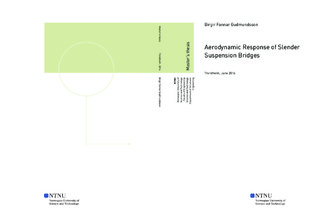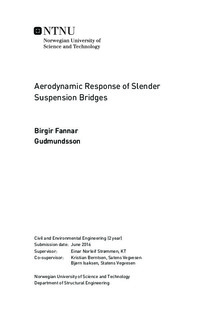| dc.description.abstract | The design and construction of the new coastal highway E39 along the west coast of Norway involves great challenges due to the large width and depth of the fjords along the coast. The new bridges involved in this project are very long and slender, which means aerodynamic design is very important. This thesis studies the aerodynamic stability of one such bridge, a proposed bridge crossing the Halsafjord. This bridge is a single span suspension bridge with a main span of 2050 meters, and a streamlined dual box girder deck, 32 meters wide in total.
The solution has been pursued in modal coordinates and in the frequency domain. The eigenfrequencies and eigenmodes have been calculated using the calculation program ALVSAT, and the numerical analysis of the bridge has been performed in MATLAB. Only the lowest vertical and torsion modes are considered in this analysis. The aerodynamic derivatives are determined from indicial functions obtained experimentally from wind tunnel testing.
A stability limit is identified by investigating where the response is greatly increased for a small increase in mean wind velocity until it approaches infinity. It has been concluded that flutter is the only type of instability that can affect the bridge. It is shown that while both the vertical and torsional modes gain considerable damping, motion induced loss of stiffness in torsion is the main driving force for the loss of stability. The calculations show that the flutter stability limit occurs only after the vertical and torsion modes have coupled, and that their cooperation alongside the loss of torsional stiffness cause the combined vertical-torsion peak in the frequency response function to be larger than the original peaks at V=0. | |

